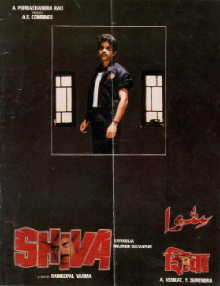
Shiva is a 1990 Indian Hindi-language action drama film written and directed by Ram Gopal Varma. It was a remake of Varma's debut Telugu film, Siva (1989). The film has Nagarjuna and Amala in lead roles with Raghuvaran and J. D. Chakravarthy as the antagonists. All four actors reprise their roles from the original Telugu film. The film became a blockbuster. The success led to Ram Gopal Varma directing a prequel in 2006 which has no connection to the original except similar name.

Penmetsa Ram Gopal Varma, often referred to by his initials RGV, is an Indian film director, screenwriter and producer, known for his works in Telugu cinema in addition to Hindi, Kannada language films, and television. Varma has directed films across multiple genres, including parallel cinema and docudrama noted for their gritty realism, technical finesse, and craft. Regarded as one of the pioneers of new age Indian cinema, he was featured in the BBC World series Bollywood Bosses in 2004. In 2006, Grady Hendrix of Film Comment, published by the Film Society of Lincoln Center cited Varma as "Bombay's Most Successful Maverick" for his works on experimental films.

Akkineni Nagarjuna Rao, known mononymously as Nagarjuna, is an Indian actor, film producer, television presenter, and entrepreneur. Nagarjuna has acted predominantly in Telugu cinema, along with a few Hindi and Tamil films. He received two National Film Awards namely, for Ninne Pelladata (1996), which he produced won the Best Feature Film in Telugu and a Special Mention as actor for Annamayya (1997); nine state Nandi Awards, and three Filmfare Awards South.

Okkadu is a 2003 Indian Telugu-language romantic sports action film directed by Gunasekhar and produced by M. S. Raju. The film stars Mahesh Babu, Bhumika Chawla and Prakash Raj. The music was composed by Mani Sharma, while the cinematography and editing were handled by Sekhar V. Joseph and A. Sreekar Prasad.

Hello Brother is a 1994 Indian Telugu-language action comedy film, produced by K. L. Narayana and directed by E. V. V. Satyanarayana. It stars Nagarjuna, Ramya Krishna and Soundarya, with music composed by Raj–Koti. The film is entirely based on the Hong Kong action comedy Twin Dragons (1992). In turn, Hello Brother spawned several of its own remakes, twice in Hindi as Judwaa (1997) and its reboot Judwaa 2 (2017) and in Kannada as Cheluva (1997). The film was the highest grossing Telugu movie of 1994.

Nagulapati Srinivasa Chakravarthy, known professionally as J. D. Chakravarthy, is an Indian actor, filmmaker, screenwriter and musician known for his work primarily with Telugu cinema in addition to Hindi, Tamil, Malayalam, and Kannada films. Chakravarthy made his screen debut with the Telugu film, Siva, an action blockbuster directed by Ram Gopal Varma, featured at the 12th IFFI. He subsequently made his Bollywood debut with the remake of the same film titled Shiva (1990). He then starred in the blockbuster Satya, featured in the Indian panorama section at the 29th IFFI, and was listed among CNN-IBN's 100 greatest Indian films of all time. Chakravarthy received the Screen Award Special Jury Award.

Amala Akkineni is an Indian actress, Bharatanatyam dancer, and activist. She has predominantly worked in Tamil films, in addition to Telugu, Hindi, Malayalam, and Kannada-language films. She was a leading actress in the Tamil film industry from 1986 to 1992 and has appeared in many blockbusters in Tamil and other languages. She has won two Filmfare Awards South, namely Best Actress – Malayalam for the 1991 film Ulladakkam and Best Supporting Actress – Telugu for the 2012 film Life Is Beautiful. Amala is the co-founder of Blue Cross of Hyderabad, a non-government organisation (NGO) in Hyderabad, India, which works towards the welfare of animals and preservation of animal rights in India.
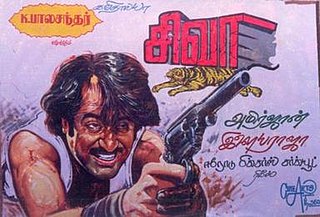
Siva is a 1989 Indian Tamil-language action film directed by Ameerjan. The film stars Rajinikanth, Raghuvaran, Sowcar Janaki and Shobana. It is a remake of the 1977 Hindi film Khoon Pasina. The film was released on 5 May 1989 and became a box-office bomb.

Tanikella Bharani is an Indian actor, screenwriter, poet, playwright and director who works predominantly in Telugu cinema. He has worked as an actor in more than 750 films, including some in Tamil and Hindi; while he was also screenwriter for 52 films. He has won three Andhra Pradesh State Nandi Awards.
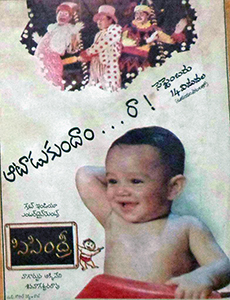
Sisindri is a 1995 Indian Telugu-language comedy film directed by Siva Nageswara Rao and produced by Nagarjuna. The film stars Nagarjuna's son Akhil Akkineni. Nagarjuna Akkineni, Giri Babu, Tanikella Bharani, Sudhakar, Aamani, Sarath Babu and Subhalekha Sudhakar play supporting roles. Music is composed by Raj, his debut film. The film is inspired by the American film Baby's Day Out (1994).

Damarukam is a 2012 Indian Telugu-language action fantasy film written and directed by Srinivasa Reddy, and produced by R. R. Venkat on R. R. Movie Makers. It stars Nagarjuna, Anushka Shetty, Prakash Raj, and P. Ravishankar. The music is composed by Devi Sri Prasad with cinematography by Chota K. Naidu.

Bejawada or Bezawada is a 2011 Indian Telugu-language action crime film based on the Vijayawada Gang Warfare, directed by Vivek Krishna and produced by Ram Gopal Varma and Renny Johnson. The film stars Naga Chaitanya and Amala Paul. The movie was received negatively at the box office but positively at the television and OTT as it accurately depicted the historical gang war in Vijayawada. Later it was dubbed in Hindi as Hero: The Action Man (2013) and also in Tamil as Vikram Dhadha. It marked Amala’s Telugu debut.

Kirayi Dada is a 1987 Indian Telugu-language action drama film produced by V. Doraswamy Raju under VMC Productions and directed by A. Kodandarami Reddy. It stars Nagarjuna, Amala, Khusboo, Krishnam Raju, Jaya Sudha and music composed by Chakravarthy. This film is a remake of the Hindi movie Jaal (1986). This was Amala's Telugu debut and after this film, she'd played some other leading roles with her future husband, Nagarjuna and the duo's pair was considered the finest amongst the Tollywood.
The Akkineni–Daggubati family is a prominent Indian film family with a history predominantly in Telugu cinema. Akkineni Nageswara Rao and Daggubati Ramanaidu are the prominent heads of both families. Members of the family include actors, film directors, and producers.

Nagarjuna is an Indian actor and producer who works in the Telugu cinema. He has acted in over 100 films as a lead actor as well as playing supporting and cameo roles, including Hindi and Tamil cinema. He has received nine state Nandi Awards, three Filmfare Awards South, and one Special Mention at the National Film Awards. The 1996 film Ninne Pelladata which he produced, was declared the Best Telugu film of the year at the National Film Awards.

Akhil Akkineni is an American actor based in India, who works in Telugu cinema. Akhil was born in San Jose, California, and was raised in Hyderabad, India. Akhil debuted as a child artist in the children's film Sisindri (1994), for which he won a Filmfare Special Award. He is also the captain of Telugu Warriors cricket team that competes in Celebrity Cricket League.

Chinababu is a 1988 Telugu-language drama film, produced by D. Ramanaidu under the Suresh Productions banner and directed by A. Mohan Gandhi. It stars Nagarjuna, Amala Akkineni and music composed by Chakravarthy. The film was dubbed in Tamil as Paasathai Thirudathe.
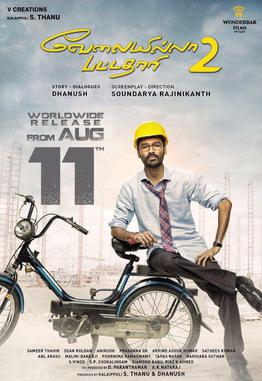
Velaiilla Pattadhari 2 is a 2017 Indian Tamil action comedy film directed by Soundarya Rajnikanth. It is a sequel to the 2014 film Velaiilla Pattadhari and has Dhanush, Amala Paul, Vivek, Hrishikesh, Saranya Ponvannan, and Samuthirakani reprising their roles, while Kajol plays an antagonistic role, marking her return to Tamil cinema after 20 years, with her last film being Minsara Kanavu (1997). Ritu Varma was recast as Anita, earlier played by Surbhi, which marks her debut in Tamil cinema. Some of Dhanush's scenes were partially reshot in Telugu. Its music was composed by Sean Roldan.

Officer is a 2018 Indian Telugu-language action film produced and directed by Ram Gopal Varma on his R Company Production banner. The film stars Nagarjuna Akkineni, Myra Sareen in the lead roles and music composed by Ravi Shankar. The Tamil dubbed version, Simtaangaran was released on 1 January 2021.
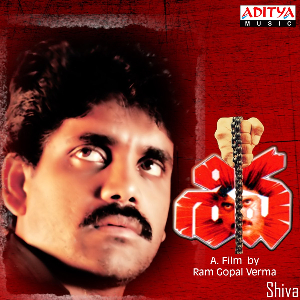
The five-song soundtrack album and background score of the Telugu-language crime action film Siva (1989) is composed by Ilaiyaraaja. The film, directed by Ram Gopal Varma and produced by Annapurna Studios and SS Creations, stars Nagarjuna, Amala Akkineni, Raghuvaran and J. D. Chakravarthy. Veturi Sundararama Murthy and Sirivennela Seetharama Sastry wrote lyrics for the songs, while S. P. Balasubrahmanyam, S. Janaki, K. S. Chithra, S. P. Sailaja and Mano were the singers. The soundtrack was successful and was acclaimed as one of Ilaiyaraaja's best works in Telugu cinema.




















